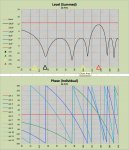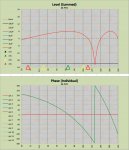Re: Endfire sub array under a stage
Art, the cardioid array had the exact same frontal area and exhibited the exact same loss.
Art, the cardioid array had the exact same frontal area and exhibited the exact same loss.
Peter,
Jamie Anderson and I measured this exact effect at the second to last get together in MA a few years ago. We found there was about 2dB of loss, fairly broadband, going from the 3 high array to either "bottom box reversed cardioid" or "three in a line really close endfire". I am sure that DDT doesn't show this because, like basically all programs, it doesn't account for acoustic radiation impedance. Doing so is extremely complicated, processor intensive, and prone to error. Basically you have to do a finite element plot for every point you want to predict, much more complicated than the otherwise quite accurate superposition of phase and magnitude most (all?) visual prediction programs use.
Hi Michael,
See the post I linked to below. It shows an endfire array that Peter and I used earlier this year.
It performed very well, just as the predictions modelled! Although our main goal was to keep energy from the 2 outside stages I also walked the main stage with the subs running and the levels were quite minimal. Cancellation in the hypercardioid nulls was extremely effective.
Darren
http://soundforums.net/varsity/7065...our-subwoofer-configurations-2.html#post55111




So what exactly do you mean by "throw"?I did an endfire arrangement under a stage this summer which worked very well. It was three Bag End D18Elf speakers per side, laying on their sides underneath the PA hang bays, spaced 5' facing forward and delayed appropriately.
They had been stacked in previous years three high on their sides on each side of the stage, which caused lots of complaints from behind the stage, and had no where near the throw that this configuration has.
.
So what exactly do you mean by "throw"?
Are you saying they were louder out front? If so-that goes against all of my (and others) testing with directional arrays.
Do you have any measurements to show that?
More than likely what you were "experiencing" was simply less of "other sound" that comes from the subs spraying energy all over the place. So you heard more of the direct sound and less of the "reflected".I mean that the sub impact at the back of the field was greater in this configuration than with the stacked boxes.
.
More than likely what you were "experiencing" was simply less of "other sound" that comes from the subs spraying energy all over the place. So you heard more of the direct sound and less of the "reflected".
I still disagree. Even though a sub cabinet may not be on the ground-you will still get "ground coupling" at bass freq-up to a certain height. Or course it depends on the freq and the height of the cabinet.Maybe, but I don't think so. There's really nothing within a very long distance to give significant reflections from behind the stage. The reflecting surfaces that are present are in the path of the desired sound and so still in the equation.
Like I said, I think the improvement was due to effectively 24 drivers due to ground coupling vs. 16 with the vertical stacks.
Jared,
I wrote two subwoofer articles for Live Sound mag back in 2010. They might be helpful to you
http://bennettprescott.com/downloads/SubwooferArraying.pdf
http://bennettprescott.com/downloads/AdvancedSubwooferArraying.pdf
Jared,
I wrote two subwoofer articles for Live Sound mag back in 2010. They might be helpful to you
http://bennettprescott.com/downloads/SubwooferArraying.pdf
http://bennettprescott.com/downloads/AdvancedSubwooferArraying.pdf
